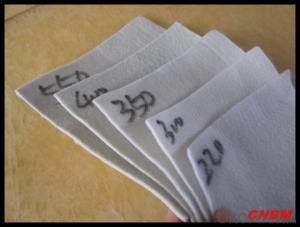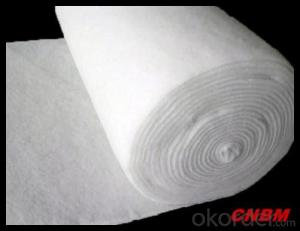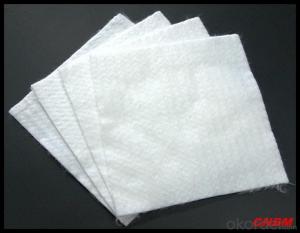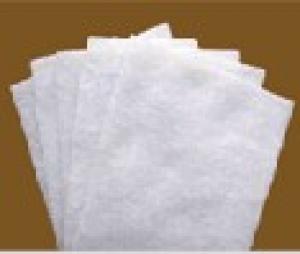Geotextile Talus Nonwoven Geotextile High Strength PET & PP for Construction
- Loading Port:
- China main port
- Payment Terms:
- TT OR LC
- Min Order Qty:
- 3000 m²
- Supply Capability:
- 1000000 m²/month
OKorder Service Pledge
OKorder Financial Service
You Might Also Like
Specification
Product Introduction
Composite Geomembrane-Long filament geocomposite made of geotextile non woven and geomembrane


1.Characteristic: with high intensity and great elongation, large amount of modulus, acid-proof and alkali resistance, anticorrosive, with great tearing Strength and Brush Strength, fine spinning stickiness, good performance of anti-ageing and anti-freezing (won’t become embitterment even in 700Centigrade degree), with width of 5.0 meter.
2.Use: play the function of preventing seepage, separating, anti-cracking, consolidating, water draining in the horizontal plane in the projects, especially suitable for the seepage preventing projects with high watermark and water pressure.
3.Application: mainly be applied for the seepage-preventing projects in the railway bed, reservoir dam, rubbish landfill yard, tunnel and dyke.
1) Weight / Mass: 100g/m2-800g/m2
2) Width: Within 6 m (1m-6m)
3) Length: 50m-100m/roll (as request)
4) Material: PP / PET
5) Color: Black , white , grey and other color
6) Certificate: CE/ISO9001 , ISO14001
7) Manufacturing method: nonwoven / woven
8) The Biggest geotextile manufacturer/factory in China for many years
Geotextile Type:Non-Woven Geotextiles
Packaging & Shipping
Packing: PLASTIC FILM INSIDE, AND WOVEN BAG OUTSIDE
Shipping: About 15 days after receipt the deposit
geotextile fabric
permeability,filtration,easy for construction
ISO and CE certificate
Good quality and competitive price
Our Service
Quality assurance
1.On a regular basis or as per your request,we entrust national testing agencies to conduct quality inspections
2. Strictly in accordance with the ISO9001-2008 international quality system standard,we monitor and manage the whole process throughout production,quality testing,and measurement to ensure product quality
3. For quality-related construction delay or substandard construction(except for damage or losses due to customer’s responsibility or irresistible natural disasters),we have refunding,replacement,and repair services.We will respond to customers’ feedbacks on quality issues within 24 hours.
FAQ:
Q: What kind of payments does jenor support?
A: T/T, L/C, Cash are accepted.
Q: Do you charge for the samples?
A: Accordeing to our company policy, the samples are free, we only charge the freight fee. And we will return the freight fee during the next order.
Q: Can you produce according to customers' design?
A: Sure, we are professional manufacturer, OEM and ODM are both welcome.
Q: Do you have other products?
A: Yes, please check the pictures:
- Q: Where is the geotextile in the municipal works?
- Conservation, consideration, there is more green and more Chinese geotextile material manufacturers
- Q: How do geotextiles contribute to the stability of road embankments?
- Geotextiles contribute to the stability of road embankments by providing reinforcement and separation. They act as a barrier between the different layers of soil, preventing their intermixing and maintaining their individual integrity. This enhances the load-bearing capacity of the embankment, reducing settlement and improving its overall stability. Geotextiles also help in drainage by allowing water to pass through, preventing excess moisture buildup that can weaken the embankment.
- Q: Contracted geotextile impermeable membrane laying artificial one square how much money
- Big bag of 4 yuan / square, I am specializing in the production of geotechnical materials
- Q: How are geotextiles used in civil engineering?
- Geotextiles are extensively used in civil engineering as a versatile material for various applications. They are commonly employed for soil stabilization, erosion control, drainage management, and reinforcement purposes. Geotextiles can be installed to prevent soil erosion on slopes, act as a separation barrier between different soil layers, provide filtration in drainage systems, and enhance the strength of embankments or roads. Their permeable nature allows for water and gas flow while effectively retaining soil particles, making them an essential component in many civil engineering projects.
- Q: What are the composite geomembranes suitable for use? What are the characteristics of it? There are several kinds of composite geotextiles?
- Widely used in water conservancy, chemical industry, construction, transportation, subway, tunnel, garbage disposal field and other anti-seepage project, high puncture resistance, large coefficient of anti-aging performance, to adapt to the environmental temperature range Excellent anti-drainage performance Geotextile: A cloth a film two cloth a film a cloth two films more cloth film and so on
- Q: Tunnel without sand concrete, geotextile, seepage blind pipe construction sequence
- In accordance with the order of seawater blind pipe geotextile sandless concrete, I specialize in producing geotextile materials
- Q: Can geotextiles be used in underground construction projects?
- Yes, geotextiles can be used in underground construction projects. Geotextiles provide various benefits such as soil stabilization, erosion control, filtration, and drainage, making them suitable for use in underground applications like tunnels, retaining walls, and underground drainage systems. They help improve the overall performance and longevity of the underground structures.
- Q: High-speed rail 2-type sliding layer to use two cloth a film, geotextile wool surface close to the concrete, but in the geotextile between the smooth and matte surface there is controversy, both sides of the geotextile is fluffy soft , A smooth side of some hard, hope to understand the master to answer the hairy side is smooth or matte surface? Thank you more
- You do not call geotextile cloth, you called the permeable template cloth, geotextile cloth on both sides of the hair!
- Q: Are geotextiles suitable for use in geocell retaining walls?
- Yes, geotextiles are suitable for use in geocell retaining walls. Geotextiles help in enhancing the structural stability of the geocell walls by providing soil confinement, filtration, and erosion control. They prevent soil migration, improve drainage, and increase load-bearing capacity, making geotextiles an ideal choice for reinforcing geocell retaining walls.
- Q: What are the factors to consider when selecting geotextiles?
- When selecting geotextiles, some important factors to consider include the type of project or application, the required strength and durability, the desired permeability and filtration properties, the site conditions such as soil type and slope, the installation and maintenance requirements, as well as cost-effectiveness.
Send your message to us
Geotextile Talus Nonwoven Geotextile High Strength PET & PP for Construction
- Loading Port:
- China main port
- Payment Terms:
- TT OR LC
- Min Order Qty:
- 3000 m²
- Supply Capability:
- 1000000 m²/month
OKorder Service Pledge
OKorder Financial Service
Similar products
Hot products
Hot Searches
Related keywords






























